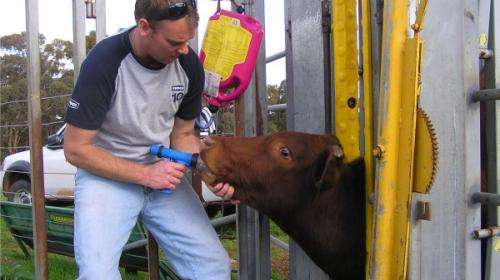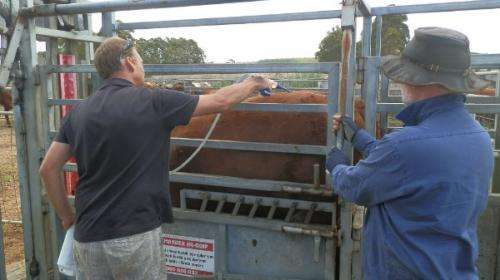Cattle parasite found to be widespread

WA researchers have discovered widespread resistance to roundworm treatments across south-west beef cattle farms.
Department of Agriculture and Food WA Albany district office principal veterinary parasitologist Brown Besier, field officer Jennifer Cotter and statistician Andrew Van Burgel surveyed 19 beef cattle properties between New Norcia to Albany and Donnybrook to Esperance in 2010 and 2011.
They conducted pre-treatment faecal worm egg counts in 60 cattle on each farm, including Angus, Hereford and Murray Grey breeds, compared to counts 14 days after chemical treatments against nematodes, or parasitic roundworms.
Roundworms are found in cattle's stomach and small intestine, causing diarrhea, malnutrition and poor growth.
The 60 cattle were divided into four groups of 15 animals and received either injectable treatment ivermectin, oral treatments fenbendazole or levamisole and a control group received no treatment.
Dr Besier says their findings were unexpected.
"We thought we would find a few farms with evidence of resistance to the drenches but to our surprise…we found that in two thirds of farms drenches were not as effective as they should be," he says.
"We did not think it would be anything like that, it had really gone much further than we thought."
Dr Besier says 17 of the 19 properties did not have the expected 100 per cent kill rate after drench application, including for small intestinal worm (Cooperia oncophora) and brown stomach worm (Ostertagia ostertagi).

"We found that there were cases for every one of the drenches where worms had survived so we can say the problem…is not confined to any one type," Dr Besier says.
Fifty-nine per cent of C.oncophora tests showed resistance to ivermectin, which was fully effective against O.ostertagi, while O.ostertagi showed resistance to fenbendazole (50 per cent) and levamisole (67 per cent), which were fully effective against C.oncophora.
Dr Besier says the prevalence of ineffective drenching regimes is concerning.
"We see this as a bit of a bellwether…that there is a problem developing and we are lucky that so far it has only involved this minor Cooperia worm," he says.
"But as time goes on the risk is some of the more damaging stomach worms will get involved and that will start costing farmers serious money.
"At this point…as far as an impact on the farm industry goes it would be a moderate rather than a severe affect but it has the potential to spill over into other worms."
More information: "Anthelmintic resistance in nematodes of beef cattle in south-west Western Australia," Veterinary Parasitology, Volume 207, Issues 3–4, 30 January 2015, Pages 276-284, ISSN 0304-4017, dx.doi.org/10.1016/j.vetpar.2014.11.019
Journal information: Veterinary Parasitology
Provided by Science Network WA


















